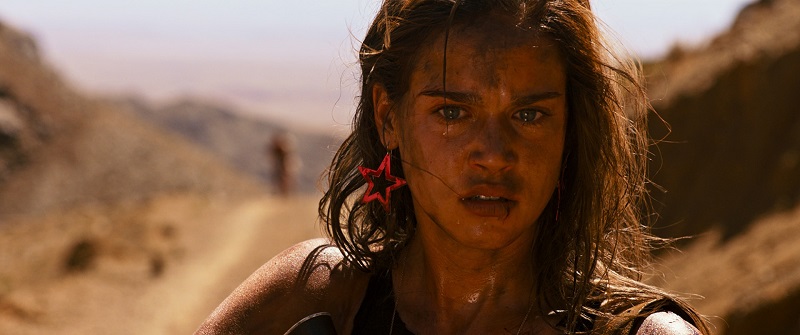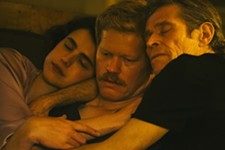Coralie Fargeat Gets Revenge on the Male Gaze
Writer/director flips the script on action movies
By Richard Whittaker, 8:00AM, Fri. May 11, 2018
Revenge, the debut feature by French director Coralie Fargeat, has been lauded for upending the grisly rape-revenge genre. But for Fargeat, seeing it solely through that prism focuses too narrowly on one facet. "For me, this is not just about the rape. It is more about the male gaze in general."
The rape-revenge genre has always been a troubled one: Its most disturbing examples, like the early Seventies' one-two of Last House on the Left and I Spit on Your Grave, were graphic and disturbing, and condemned for it, while sleazier, exploitative iterations (like the Last House remake) end up fetishizing rape. However, when Fargeat started writing the script, rape was not a factor at all. "In fact, I really didn't want, at the beginning, to make a rape and revenge film. I haven't watched almost any of those movies, except for The Last House on the Left. ... I was much more inspired by movies like Kill Bill, Rambo, Mad Max, which are creating a hero that has been confronted by an unfair situation, who is going to be raised and reborn again."
However, she added, "When I started developing this idea, the most extreme and most violent thing that could happen to her, in a way that men could consider her as nothing, is the rape. But it came for me as a symbol, and as an extreme moment of many of the things that she has to endure."
When future victim/future warrior Jen (Matilda Anna Ingrid Lutz) first appears, she's shown out of focus, in the back of a car, wearing shades, with a sucker in her mouth. That was a deliberate reference: Fargeat called her "the pure Lolita, very seductive kind of girl, and for that she's going to be considered very weak, and that she can be used, and she can be erased when those guys don't need her anymore."
Austin Chronicle: The rape is not the only trauma Jen experiences, not even the only act of penetration. You subject her to an awful lot.
Coralie Fargeat: I think for the rebirth to be very powerful, the crash has to be as powerful. I also needed a lot of symbols, and an impalement can remind you of the crucifixion. In the unconscious mind, in representation, it's not just the same as when you crash onto the floor. The fact that she stays alone, impaled, in the sun, in the middle of nowhere, its a powerful image. And I think it's good not to fear to go too far, because I think in cinema that's what creates very special moments. I remember in The Revenant, (director Alejandro González Iñárritu) didn't fear to go too far. I think that's what makes this story a cinematic story, and not just a realistic story, and that's where I wanted to go. Something supernatural, or bring her back from the dead, and start building an icon of a superhero. For that, I think you have to go very far into the dark and into the pain that she suffers, so she can be reborn equally on the other side.
CF: When I started to create the action scenes, I liked the idea that each chase was going to be very specific, and also use a very different landscape, and give different feelings about it. I was also guided by the fact, from the beginning when I started writing, that I didn't want my heroine to be screaming all the time, like in typical horror films where the girl shouts and is in pain. I wanted quickly for her to find a way to get strong, and to be on a quest where she wasn't suffering, but coming out of herself, and transforming into somebody else.
I didn't want all the fights to be very realistic, so also with that came the idea that she has these superpowers. After she emerges, she can walk barefoot, she can use a gun, and I loved the imagery around that, because it allowed me to have a lot of fun about thinking about the different chases, and be more and more violent, and more and more metaphysical. In each fight, it's the two mentalities of the people who are fighting. In the mountain, its all the dumbness and the weakness of the guy, with him being annoyed with his car, with him fighting a piece of glass. ... My intention was that the mind of the characters was going to be more important than the fight, and that allows me to push the buttons, to go very far in a very crazy way, and that's what I like. To be excessive in those moments, to be very bloody, to be very baroque. I think that's the kind of violence that I like, rather than realistic suffering, which I'm not very interested in.
Knowing that I would not have a big budget, so I couldn't do huge explosions and very impressive action scenes, helped me to find how powerful I could be using very few elements, and bringing them to create something very original. That's how everything builds all together.

AC: The fights also depend on very different environments – a watering hole, a mountain, the villa – and a sense of geography can be vital in an action sequence. I rewatched Predator recently, and the final sequence makes sense because they use the space. It's not just some random jungle. You do the same here, using the space and making it explicitly the environment, and not just a backdrop.
CF: For me, putting it in a very rough and tough environment was part of what I wanted, to take it away from everyday life. I didn't want the film to happen somewhere which has already been seen a lot, and I wanted it to bring a lot of mythology. I think the desert is for me the perfect mirror of what's going to happen to the characters. It's hell on Earth, and the more crazy the characters go, the more out of control they are, and the further from civilization they get, the more the desert becomes symbolically the perfect mirror of the story. I wanted to play with the idea that the landscape could be a character in itself – push the color, push the weights, everything is sweating, everything is harsh.
AC: There's an idea in female-led action films of the tank top moment, where she takes her shirt off a sign of empowerment, and she's wearing a tank top. You reverse that with a lot of male nudity. In another film, it would be the female protagonist who gets the weapon, yet is more exposed, and you invert that by stripping Richard (Kevin Janssens) and have this long tracking shot of him, naked. You're exposing your male antagonist.
CF: When I started to think about this scene, I was really fascinated when I realized that I had almost never seen a naked guy in a film. We're very used to conventions that, unconsciously, we are reproducing. You're so used to seeing them on screen that, when you write, you reproduce them. The nudity of the antagonist was, for me, the perfect way to bring something so powerful to the scene, and to reverse, at the same time, all the conventions.
I also liked the idea that this guy, who thinks he can bend the world to his will, that he can solve everything with money, with power, and who is used to having powerful symbols – leather jacket, big car, the gun, the villa – at the end is going to be confronted in his simplest way.
Also, the nudity of the guy is a very cinematic, powerful element for bringing something else to the scene. Because I couldn't have a lot of explosions, I had to find something else to make the scene striking, to make the scene tense.
Revenge is in cinemas now. For review and showtimes, visit our listings page.
A note to readers: Bold and uncensored, The Austin Chronicle has been Austin’s independent news source for over 40 years, expressing the community’s political and environmental concerns and supporting its active cultural scene. Now more than ever, we need your support to continue supplying Austin with independent, free press. If real news is important to you, please consider making a donation of $5, $10 or whatever you can afford, to help keep our journalism on stands.
Richard Whittaker, July 23, 2018
Richard Whittaker, Oct. 10, 2017
June 27, 2024
June 28, 2024
Coralie Fargeat, Matilda Anna Ingrid Lutz, Revenge, Neon, Kevin Janssens











